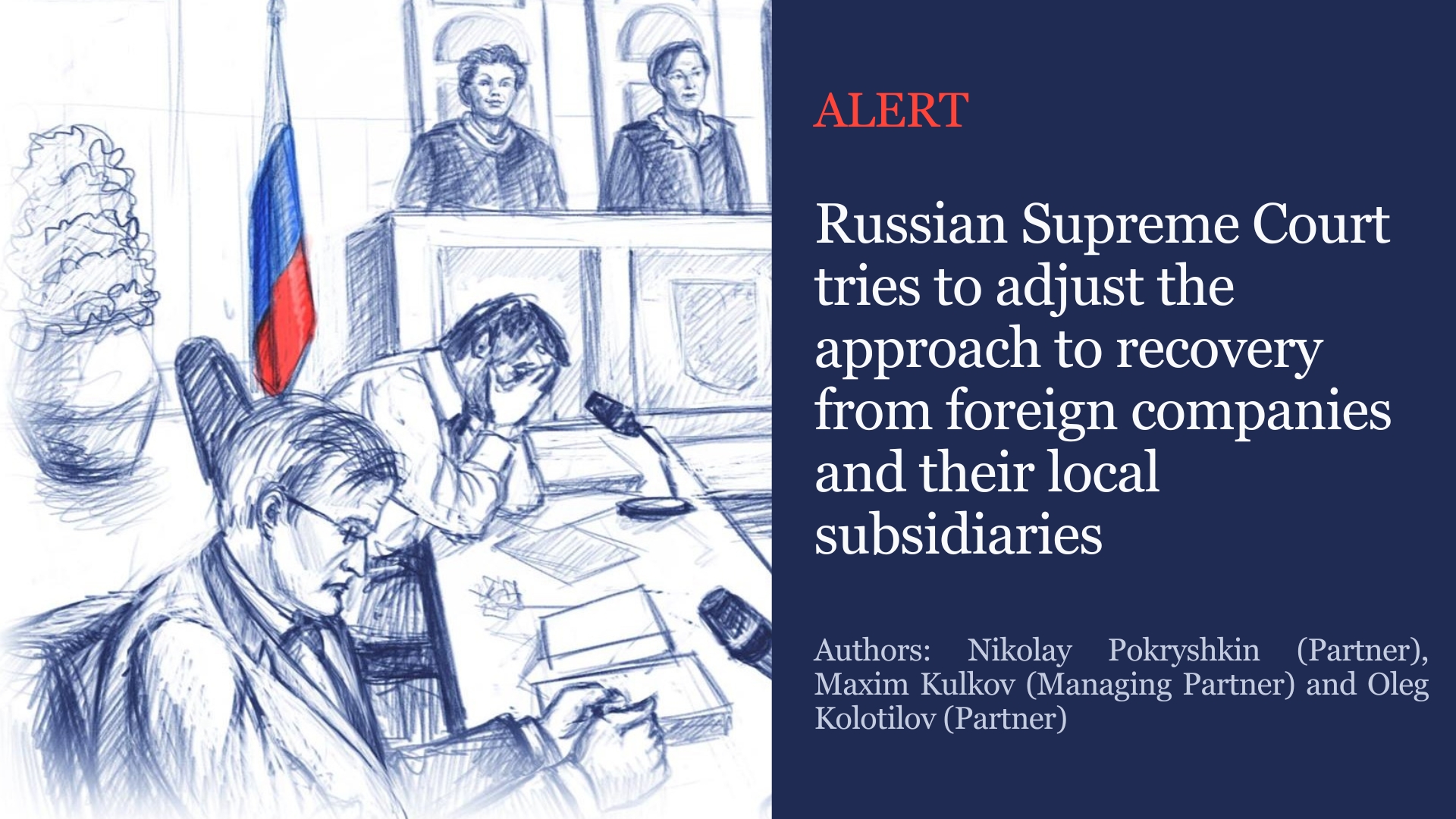Russian Supreme Court tries to adjust the approach to recovery from foreign companies and their local subsidiaries
On 13 May 2025, the Supreme Court of the Russian Federation (the SC RF) published a Ruling in Case No. A40-167352/2023 (the Citi Case) motivating the cancellation of judgments of the lower courts that had previously admitted bringing Russian subsidiaries (Subsidiaries) to tort liability for their failure to fulfil contractual obligations of foreign parent companies (Foreign Entities) due to sanctions.
The position of the SC RF might be described as a ‘Judgment of Solomon’: contrary to the expectations of the Foreign Entities, the SC RF did not completely exclude the possibility of bringing the Subsidiaries to liability, but also did not support the already widespread ‘unconditional’ imposition of obligations of the Foreign Entities on Subsidiaries without regard to the context, which has been repeatedly used by Russian creditors (Claimants).
However, neither party was given legal certainty or a clear test for imposing liability, which has granted Subsidiaries and Foreign Entities additional defences briefly highlighted below.
- The SC RF generally confirmed the need for Claimants to apply for a licence / unblocking from a foreign regulator as a condition for the satisfaction of tort recovery claims, but made such a need dependent on (i) the compliance of the foreign unblocking regime with Russian law; and (ii) the Russian Central Bank’s (CBR) opinion on the matter.
This strengthens the Foreign Entities’ argument that there is no tort until the foreign regulator refuses to issue a licence / unblock the funds. Whereas the defence argument was previously based only on the SC RF’s ruling of 20 November 2023 in Case No. A40-179021/2022 (rendered in a dispute between Russian entities, which was usually pointed out by the Claimants referring to the inapplicability of the position to disputes with Foreign Entities), the SC RF has now explicitly confirmed the applicability of the approach in the case of attempts to recover from Foreign Entities as well.
However, Foreign Entities should now be prepared for a fierce debate as to whether the specific measures, the steps taken by the Claimants, and the procedure for contacting a foreign regulator (the Unblocking Procedure) are ‘in compliance’ with Russian law. Obviously, the Claimants will try to interpret the Citi Case in such a way that would mean the sanctions regime as a whole (and thus the Unblocking Procedure) is contrary to Russian public policy and, therefore, any Unblocking Procedure is contrary to Russian law. However, the Foreign Entity may argue that this approach is untenable:
- on the one hand, this interpretation makes no sense of the position of the SC RF in the Citi Case since the obvious illegality of any Unblocking Procedure would exclude both the expediency of cancelling the judgments in the Citi Case and the point of the SC RF establishing a test for the compliance of the Unblocking Procedure with Russian law;
- on the other hand, the Foreign Entity may present a counter-version (‘narrow’ interpretation): if the very actions of the Claimant under the Unblocking Procedure do not entail a violation by that entity of Russian laws, then the Claimant is obliged to take those actions before filing a claim with a Russian court. The test introduced by the SC RF is aimed only at relieving Claimants of the obligation to take actions contrary to Russian law (for example, to refuse to fulfil obligations to Russian entities or to violate Russian counter-sanctions regulations) in order to comply with the Unblocking Procedure.
Finally, Foreign Entities may try to extrapolate the approach of the SC RF: in addition to its application to tort disputes in connection with the blocking of funds and payments, it is quite possible to apply a similar approach to disputes arising from contracts (for example, supply contracts, construction contracts, bank guarantees, currency swaps, obligations in connection with securities, etc.).
While the SC RF’s ruling in the Citi Case does not expressly limit the possibility of an expansive interpretation, Foreign Entities should expect at least the following objections from the Claimants: (i) the Claimants’ attempts to comply with the Unblocking Procedure are relevant only for determining whether the harm (the tort event) has already occurred; (ii) if the claim is based on non-fulfilment of a contract, the matter of when the harm occurred does not in principle arise, and, therefore, (iii) attempts to comply with the Unblocking Procedure are irrelevant for contractual claims. However, these objections are potentially surmountable given, at the very least, the broad wording of the SC RF’s ruling in the Citi case and the very common characterisation by Claimants of their claims as ‘contractual losses’, the moment of occurrence of which may well be determined by the same logic as the moment of occurrence of the tort in its ‘pure’ form.
- The SC RF indicated that ‘it is necessary to raise a discussion between the parties of the matter’ on involving the CBR in the dispute as a third party.
Foreign Entities may use this conclusion both to involve the CBR in first instance court proceedings and to cancel court judgments that have already been rendered: in the appellate instance — to proceed the consideration of cases according to the rules of the first instance court; in the cassation instance — to send the case for reconsideration to the first instance court.
However, the SC RF did not indicate an unconditional obligation of the courts to involve the CBR and to cancel all earlier judgments (probably to avoid a total cancellation of judgments in this category of disputes), but significantly strengthened the arguments of Foreign Entities (primarily banks) on the necessity of involving the CBR.
Given the reasoning provided by the SC RF, this argument is most relevant in disputes related to the unblocking of account balances and payments as, in this context, the position of the CBR is particularly important. However, the broad wording of the SC RF allows foreign entities to raise this matter in other categories of dispute as well, especially if the issues involved in such disputes are related to the competence of the CBR (for example, in the context of the activities and the status of Russian banks with foreign participation, and sanctions and counter-sanctions regulation in general).
It is important to consider that when the CBR is involved in a case, it usually takes a passive position, not pleading on the merits of the dispute. It is unlikely that the CBR’s approach will change significantly in the future, which raises a matter for the courts: how should the absence of the CBR’s position on the merits of the case in general, and on the matter of the lawfulness of the Unblocking Procedure in particular, be assessed? Obviously, Foreign Entities should be prepared for the Claimants’ arguments that the Unblocking Procedure is unproven in the absence of the CBR’s position on the case. However, this position is quite surmountable as it is far from both the ‘special’ wording of the SC RF in the Citi Case (and earlier case law on disputes between foreign banks and Russian clients) and the general provisions of the CPC on the allocation of the burden of proof.
- The SC RF has only outlined the general factors to be considered in imposing liability on the Subsidiaries, but has not established a clear test, i.e., an algorithm for resolving the matter.
Firstly, the SC RF raised as an issue that the defendants were held jointly and severally liable, although the Foreign Entity was a contractual debtor and the tort claim was brought against the Subsidiary. However, the SC RF never made a conclusion on the admissibility of this approach, leaving considerable space for both parties to the dispute (as well as for parties to all similar cases): if such solidarity is prohibited in principle, why did the SC RF send the case for a new consideration, thus allowing the possibility of satisfying the claim? If such solidarity is permissible, why did the SC RF emphasise the inconsistency of qualification of claims against joint and several co-defendants? However, the possibility of this discussion is quite consistent with the interests of the Subsidiaries in similar disputes as it opens up the possibility of dismissal of the claim due to the errors of the Claimants in filing a solidary claim.
Secondly, the SC RF indicated some of the factors to be considered by the lower courts, however it left the significance and the correlation of these factors among themselves unclear. As a result, the factual composition necessary and sufficient to impose liability on the Subsidiaries remains uncertain, leaving both parties with considerable room for reasoning.
Therefore, the SC RF has identified the need to establish the following factors:
А. The degree of participation of each of the solidary co-defendants in incurring losses
This factor may serve as a significant defence for the Subsidiaries given that it is usually inaction (in the form of non-fulfilment of the Foreign Entities’ obligations) that is imputed to them, i.e., there is usually no active participation of the Subsidiaries in incurring losses.
B. Signs of circumvention of the law by artificial ‘splitting of business’
This criterion may be fairly presented by the Foreign Entities as an indication of the need for the courts to assess the facts evidencing the legitimate purpose of the Foreign Entities’ spinning off separate Subsidiaries to carry out operations in Russia (and the absence of a purpose to avoid recovery from the Foreign Entities). Therefore, for example, following arguments may be crucial for the Subsidiaries’ defence:
- the impossibility of direct operation of Foreign Entities in Russia due to special local regulations (e.g., due to restrictions on banking or other licensed activities by foreign entities);
- the establishment of Subsidiaries long before 2022 and their successful functioning and fulfilment of obligations in parallel with the functioning of affiliated Foreign Entities on the Russian market;
- the availability of significant assets of the Foreign Entities in Russia (including claim rights and securities) at the time of their blocking due to the Russian counter-sanctions in 2022 (which confirms that there was no Foreign Entities’ intention to avoid fulfilment of obligations by creating Subsidiaries, since the unavailability of the Foreign Entities’ assets to satisfy the claims was not and could not have been known at the time of the Subsidiaries’ creation), etc.
C. The degree of control of a foreign parent company over a Subsidiary, which is determined, among other things, by the ‘property criterion’
Previously, courts have generally been limited to assessing control using only the criteria of (i) the Foreign Entities’ direct or indirect corporate interest in the Subsidiaries (essentially the status of the Subsidiaries as the property of the Foreign Entities); and (ii) the actual ability of the Foreign Entities to give instructions to the Subsidiaries acting as a ‘decision-making centre’.
However, the SC RF indirectly confirmed the insufficiency of fulfilment of these criteria for imposing liability on the Subsidiaries and explicitly pointed out the need to investigate the third criterion (which allows us to call it ‘prevailing’ when applied together with the above criteria), namely the ‘property criterion’ defined through three indicators:
- the amount of a Foreign Entity’s investment in a Subsidiary;
- the amount of property of a Foreign Entity, which used by a Subsidiary;
- the availability and ownership by the Subsidiary of funds received from the Foreign Entity.
The novelty of this criterion gives Foreign Entities and Subsidiaries a wide range of arguments and significant grounds for cancelling judgments already rendered.
We would be happy to discuss with you in more detail the significance of the Citi Case and the defence strategy in relation to specific disputes.
Contacts:
 |
 |
 |
|
Nikolay Pokryshkin Partner +7 495 258 3941 |
Maxim Kulkov Managing Partner +7 495 258 3941 |
Оleg Kolotilov Partner +7 495 258 3941 |

